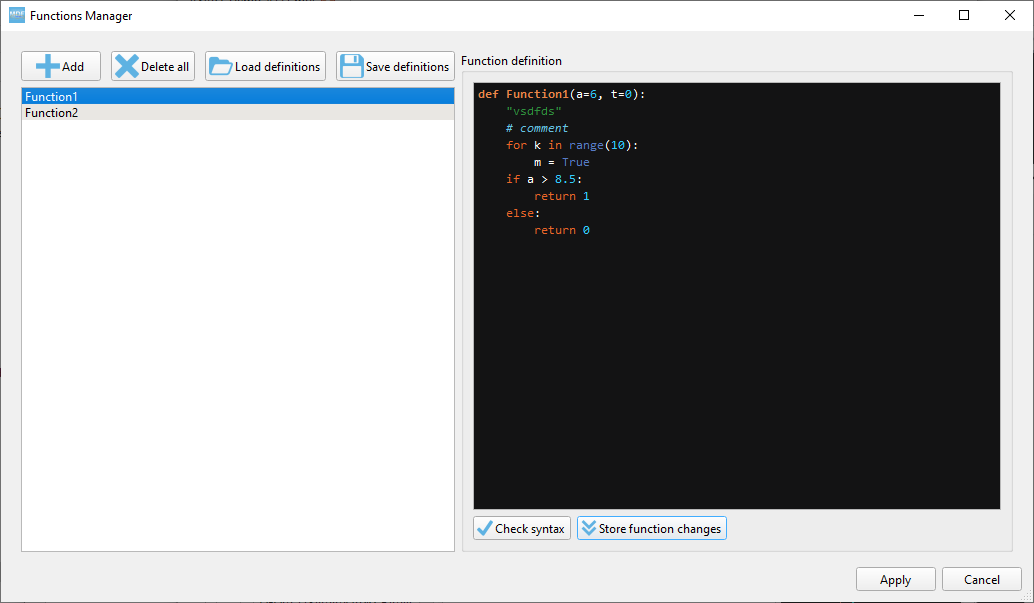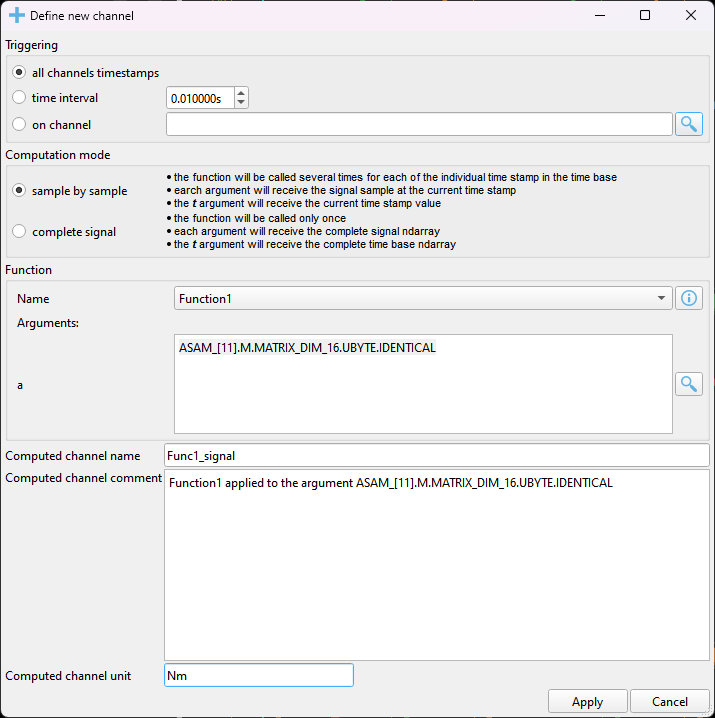Functions manager view¶
Virtual channels (computed channels) can be defined in the Plot windows. The user will
define the functions used for the virtual channels using Python language syntax; the extra rules will be described lower. After this the user
can insert virtual channels in the Plot window (keyboard shortcut Ins) and will map an existing function to the virtual channel, as well as
a list of alternative channel names (ASAPs) for each function argument.
Function manager dialog¶
The user defined functions are associated with the display file. This means that there will be separate function managers for
each opened measurement file. When a display file (.dspf) is saved by the user it will also contain the associated user defined functions.
The functions manager dialog can be invoked using the keyboard shortcut F6.

Option |
Description |
|---|---|
|
Adds a new function |
|
Deletes all the defined functions |
|
Imports definitions found in |
|
Saves all the define function to a new file with the extension |
|
Python language function definition |
|
Check if the current function definition syntax is valid |
|
Updates the definition after the user has made changes. If this is not pressed and the user switches to another function then the changes will be lost. |
|
Accept all the changes made by the user |
|
Rejects all the changes made by the user |
Python function rules¶
The user defines the functions using Python syntax; this means that the function definition must be valid in Python code.
Further more the following rules and restrictions must be followed:
all function arguments must have default numeric values: this means that the definition def Function1(a, b, t=0) is not accepted, instead the user must provide default values such as def Function1(a=1.5, b=0, t=0)
the last argument must be
t=0: the argument t is reserved for the time stamp and must not be otherwise used by the user. This means that the definition def Function1(a=1.5, b=0) is not valid, instead the user can write something like this def Function1(a=1.5, b=0, t=0)always return numeric values on all the branches: Python functions automatically return None if no return is explicitly written. The user must take care that all possible code braces return numeric values.
"this function will produce errors because not all branches have explicit return statements with numeric values" def Function1(a=0, t=0): if a > 5: return 1 "this function will produce errors because it returns non-numeric values" def Function1(a=0, t=0): if a > 5: return "Activated" else: return "Disabled" "this function is OK because it has explicit return statements with numeric values" def Function1(a=0, t=0): if a > 5: return 1 else: return 0the modules math, pandas and numpy are available inside the function as math, pd and np
functions can be cross-referenced; one function can call another user defined function
def Function1(a=0, t=0): if a > 5: return 1 else: return 0 " Function2 can call Function 1" def Function2(b=1, c=7, t=0): if b != 0: return Function1(c) else: return c / 2
Virtual channel dialog¶
Virtual channels can be added to Plot windows using the keyboard shortcut Ins (insert). The precondition for this is to
have at least one function defined in the Functions manager.
In the Define channel dialog window the user can select one of the available function, and then for each of the function’s arguments a list of alternative channel names can be filed by the user. The argument t=0 is reserved for the time-stamp and is not shown in the dialog window. The alternative names must be placed on separate lines in the text field found next to the argument name.

Option |
Description |
|---|---|
|
the virtual channel samples will be calculated in the time stamps defined by the selected choice |
|
the virtual channel can be computed passing the signal arguments samples by sample or passing the signal arguments directly as numpy ndarrays |
|
select one of the available functions |
|
displays the function definition code |
|
alternative channel names for each argument. In the example argument b will use the first existing ASAP from the choices MAIN_CLOCK or MAIN_CLOCK_5MS. If no alternative exist in the measurement file then the argument’s default value will be used (see the function definition) |
|
opens a search dialog were channel names cane be searched from the measurement file |
|
virtual channel name |
|
virtual channel comment |
|
virtual channel unit |
|
Python language function definition |
|
Check if the current function definition syntax is valid |
|
Updates the definition after the user has made changes. If this is not pressed and the user switches to another function then the changes will be lost. |
|
Accept the changes and inserts the new virtual channel |
|
Rejects all the changes made by the user |
When the computation mode is set to sample by sample the following steps are executed:
the signals linked to the arguments are searched in the measurement file
using the signals found in the measurement, the union of all time stamps is computed (resulting an ndarray of length N)
all found signals are interpolated using the union time base
the function is called N times (once for each of the N time stamps) passing the signal value for the current time stamp and the time stamp (in the t argument). The missing linked signals will be replaced by the default value specified in the function definition
the returned value are stored and finally the resulting Signal is constructed
When the computation mode is set to complete signal the following steps are executed:
the signals linked to the arguments are searched in the measurement file
using the signals found in the measurement, the union of all time stamps is computed (resulting an ndarray of length N)
all found signals are interpolated using the union time base
the function is called only 1 time passing the complete signal ndarray’s and the union of the time stamps (in the t argument). The missing linked signals will be replaced by an ndarray of length N filled with the default value specified in the function definition
the result Signal is constructed using the ndarray returned by the function
Example functions¶
Average of 3 channels¶
The same definition works for both sample by sample and complete signal computation modes
def average(channel1=0, channel2=-1, channel3=0, t=0):
return (channel1 + channel2 + channel3) / 3
Channel clipping¶
Using sample by sample computation mode
def clip(channel1=0, t=0):
if channel1 > 100:
return 100
elif channe1 < 0:
return 0
else:
return channel1
Using complete signal computation mode
def clip(channel1=0, t=0):
return np.clip(cahnnel1, 0, 100)
Grey code to decimal¶
The same definition works for both sample by sample and complete signal computation modes
def gray2dec(position_sensor_value=0, t=0):
for shift in (8, 4, 2, 1):
position_sensor_value = position_sensor_value ^ (position_sensor_value >> shift)
return position_sensor_value
Maximum of 3 channels¶
Using sample by sample computation mode
def maximum(channel1=0, channel2=-1, channel3=0, t=0):
return max(channel1, channel2, channel3)
Using complete signal computation mode
def maximum(channel1=0, channel2=-1, channel3=0, t=0):
return np.maximum.reduce([channel1, channel2, channel3])
rpm to rad/s¶
The same definition works for both sample by sample and complete signal computation modes
def rpm_to_rad_per_second(speed=0, t=0):
return 2 * np.pi * speed / 60
gradient¶
In the Define channel dialog the computation mode must be set to complete signal
def rpm_to_rad_per_second(speed=0, t=0):
return np.diff(speed) / np.diff(t)
It is not possible to implement this function in the sample by sample mode because only the current samples are forwarded to the function.
